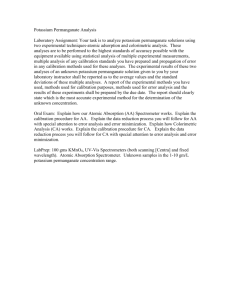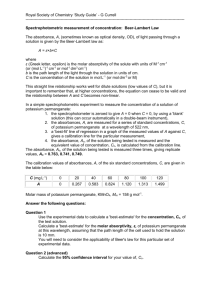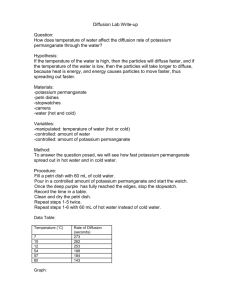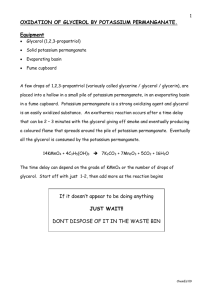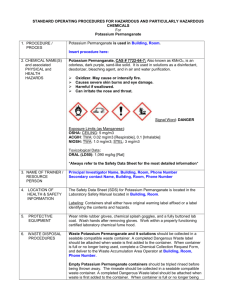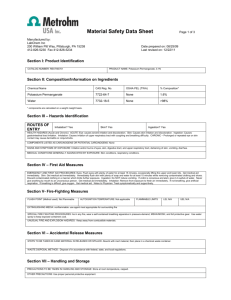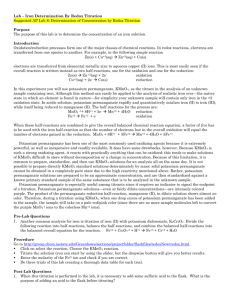Material Safety Data Sheet 0 1 Potassium permanganate
advertisement
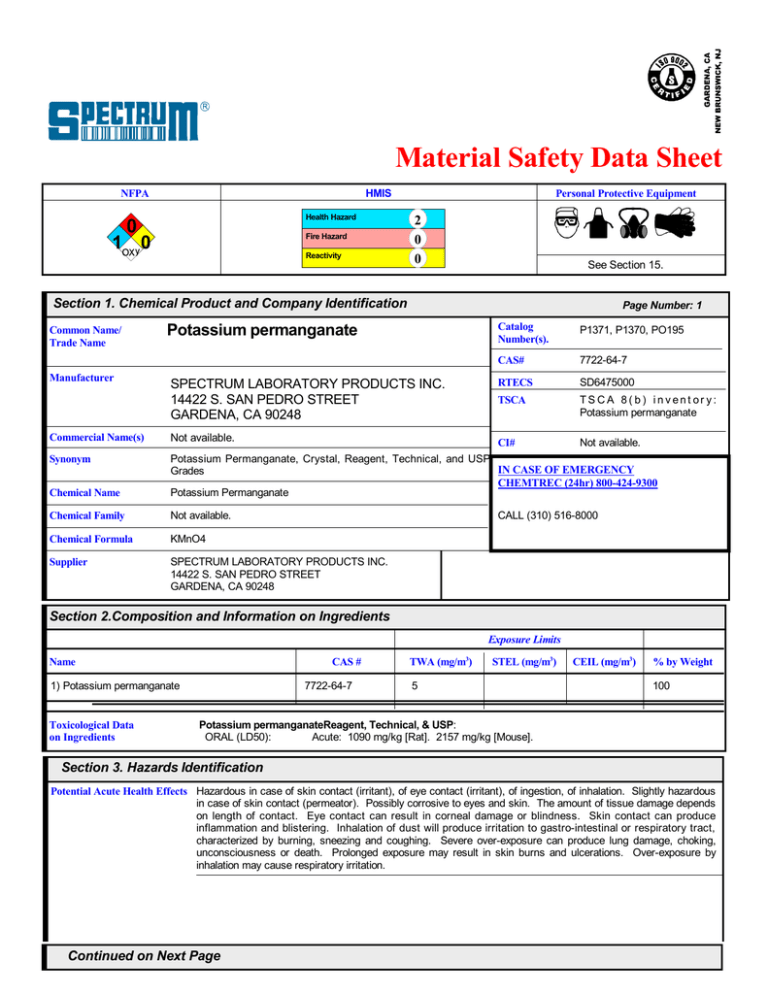
Material Safety Data Sheet HMIS NFPA 1 0 Health Hazard Fire Hazard 0 Reactivity Personal Protective Equipment 2 0 0 See Section 15. Section 1. Chemical Product and Company Identification Common Name/ Trade Name Manufacturer Page Number: 1 Potassium permanganate Catalog Number(s). P1371, P1370, PO195 CAS# 7722-64-7 SPECTRUM LABORATORY PRODUCTS INC. 14422 S. SAN PEDRO STREET GARDENA, CA 90248 RTECS SD6475000 TSCA TSCA 8(b) inventory: Potassium permanganate Commercial Name(s) Not available. CI# Not available. Synonym Chemical Name Potassium Permanganate, Crystal, Reagent, Technical, and USP IN CASE OF EMERGENCY Grades CHEMTREC (24hr) 800-424-9300 Potassium Permanganate Chemical Family Not available. Chemical Formula KMnO4 Supplier SPECTRUM LABORATORY PRODUCTS INC. 14422 S. SAN PEDRO STREET GARDENA, CA 90248 CALL (310) 516-8000 Section 2.Composition and Information on Ingredients Exposure Limits Name CAS # 1) Potassium permanganate Toxicological Data on Ingredients 7722-64-7 3 TWA (mg/m ) STEL (mg/m3) 5 CEIL (mg/m3) % by Weight 100 Potassium permanganateReagent, Technical, & USP: ORAL (LD50): Acute: 1090 mg/kg [Rat]. 2157 mg/kg [Mouse]. Section 3. Hazards Identification Potential Acute Health Effects Hazardous in case of skin contact (irritant), of eye contact (irritant), of ingestion, of inhalation. Slightly hazardous in case of skin contact (permeator). Possibly corrosive to eyes and skin. The amount of tissue damage depends on length of contact. Eye contact can result in corneal damage or blindness. Skin contact can produce inflammation and blistering. Inhalation of dust will produce irritation to gastro-intestinal or respiratory tract, characterized by burning, sneezing and coughing. Severe over-exposure can produce lung damage, choking, unconsciousness or death. Prolonged exposure may result in skin burns and ulcerations. Over-exposure by inhalation may cause respiratory irritation. Continued on Next Page Potassium permanganate Potential Chronic Health Effects Page Number: 2 CARCINOGENIC EFFECTS: Not available. MUTAGENIC EFFECTS: Mutagenic for bacteria and/or yeast. TERATOGENIC EFFECTS: Not available. DEVELOPMENTAL TOXICITY: Not available. The substance may be toxic to kidneys, liver, skin, central nervous system (CNS). Repeated or prolonged exposure to the substance can produce target organs damage. Repeated exposure of the eyes to a low level of dust can produce eye irritation. Repeated skin exposure can produce local skin destruction, or dermatitis. Repeated inhalation of dust can produce varying degree of respiratory irritation or lung damage. Section 4. First Aid Measures Eye Contact Check for and remove any contact lenses. In case of contact, immediately flush eyes with plenty of water for at least 15 minutes. Cold water may be used. Get medical attention immediately. Skin Contact In case of contact, immediately flush skin with plenty of water for at least 15 minutes while removing contaminated clothing and shoes. Cover the irritated skin with an emollient. Cold water may be used.Wash clothing before reuse. Thoroughly clean shoes before reuse. Get medical attention immediately. Serious Skin Contact Wash with a disinfectant soap and cover the contaminated skin with an anti-bacterial cream. Seek immediate medical attention. Inhalation If inhaled, remove to fresh air. If not breathing, give artificial respiration. If breathing is difficult, give oxygen. Get medical attention. Serious Inhalation Evacuate the victim to a safe area as soon as possible. Loosen tight clothing such as a collar, tie, belt or waistband. If breathing is difficult, administer oxygen. If the victim is not breathing, perform mouth-to-mouth resuscitation. WARNING: It may be hazardous to the person providing aid to give mouth-to-mouth resuscitation when the inhaled material is toxic, infectious or corrosive. Seek immediate medical attention. Ingestion Do NOT induce vomiting unless directed to do so by medical personnel. Never give anything by mouth to an unconscious person. If large quantities of this material are swallowed, call a physician immediately. Loosen tight clothing such as a collar, tie, belt or waistband. Serious Ingestion Not available. Section 5. Fire and Explosion Data Flammability of the Product Non-flammable. Auto-Ignition Temperature Not applicable. Flash Points Not applicable. Flammable Limits Not applicable. Products of Combustion Not available. Fire Hazards in Presence of Various Substances organic materials, metals, combustible materials Explosion Hazards in Presence Risks of explosion of the product in presence of mechanical impact: Not available. of Various Substances Risks of explosion of the product in presence of static discharge: Not available. Explosive in presence of organic materials, of metals. Fire Fighting Media and Instructions Not applicable. Special Remarks on Fire Hazards Spontaneously flammable on contact with ethylene glycol. Potassium Permanganate being conveyed through propylene tube ignited the tube. When solid hydroxylamine is brought into contact with solid potassium permanganate, there is produced immediately a with flame. Potassium permanganate decomposes hydrogen trisulfide so rapidly that sufficient heat is liberated to ignite the trisulfide. When Antimony or arsenic and solid potassium permanganate are ground together, the metals ignite. Continued on Next Page Page Number: 3 Potassium permanganate Special Remarks on Explosion Take care in handling as explosions may occur if it is brought in contact with organic or other readily oxidizable Hazards substances, either in solution or in dry state. Explosive in contact with sulfuric acid or hydrogen peroxide. Potassium permanganate + acetic acid or acetic anhydride can explode if permanganate is not kept cold. Explosions can occur when permanganates come on contact with benzene, carbon disulfide, diethyl ether, ethyl alcohol, petroleum, or oganic matter. Contact with glycerol may produce explosion. Crystals of potassium permanganate explode vigorously when ground with phosphorous. A mixture of .5% potassium permanganate + ammonium nitrate explosive caused an explosion 7 hrs. later. Addition of Potassium permanganate + dimethylformamide to give a 20% solution led to an explosion after 5 min. During a preparation of chlorine by addition of the concentrated acid (Hydrochloric acid) to solid potassium permanganate, a sharp explosion occurred on one occasion. Section 6. Accidental Release Measures Small Spill Use appropriate tools to put the spilled solid in a convenient waste disposal container. Large Spill Oxidizing material. Corrosive solid. Stop leak if without risk. Do not get water inside container. Avoid contact with a combustible material (wood, paper, oil, clothing...). Keep substance damp using water spray. Do not touch spilled material. Use water spray to reduce vapors. Prevent entry into sewers, basements or confined areas; dike if needed. Call for assistance on disposal. Be careful that the product is not present at a concentration level above TLV. Check TLV on the MSDS and with local authorities. Section 7. Handling and Storage Precautions Keep away from heat. Keep away from sources of ignition. Keep away from combustible material.. Do not ingest. Do not breathe dust. In case of insufficient ventilation, wear suitable respiratory equipment. If ingested, seek medical advice immediately and show the container or the label. Avoid contact with skin and eyes. Keep away from incompatibles such as organic materials, metals, acids. Storage Keep container tightly closed. Keep container in a cool, well-ventilated area. Separate from acids, alkalies, reducing agents and combustibles. See NFPA 43A, Code for the Storage of Liquid and Solid Oxidizers. Section 8. Exposure Controls/Personal Protection Engineering Controls Use process enclosures, local exhaust ventilation, or other engineering controls to keep airborne levels below recommended exposure limits. If user operations generate dust, fume or mist, use ventilation to keep exposure to airborne contaminants below the exposure limit. Personal Protection Splash goggles. Synthetic apron. Vapor and dust respirator. Be sure to use an approved/certified respirator or equivalent. Gloves. Personal Protection in Case of Splash goggles. Full suit. Vapor and dust respirator. Boots. Gloves. A self contained breathing apparatus a Large Spill should be used to avoid inhalation of the product. Suggested protective clothing might not be sufficient; consult a specialist BEFORE handling this product. Exposure Limits TWA: 5 Consult local authorities for acceptable exposure limits. Section 9. Physical and Chemical Properties Physical state and appearance Solid. Molecular Weight 158.03 g/mole pH (1% soln/water) Not available. Boiling Point Not available. Melting Point Decomposes. Critical Temperature Not available. Specific Gravity 2.7 @ 15 C (Water = 1) Vapor Pressure Not applicable. Continued on Next Page Odor Odorless. Taste Sweetish, astringent. Color Purple. (Dark.) Potassium permanganate Vapor Density Not available. Volatility Not available. Odor Threshold Not available. Water/Oil Dist. Coeff. Not available. Ionicity (in Water) Not available. Dispersion Properties See solubility in water, methanol, acetone. Solubility Easily soluble in methanol, acetone. Partially soluble in cold water, hot water. Soluble in Sulfuric Acid Page Number: 4 Section 10. Stability and Reactivity Data Stability The product is stable. Instability Temperature Not available. Conditions of Instability Incompatible materials Incompatibility with various substances Highly reactive with organic materials, metals, acids. Reactive with reducing agents, combustible materials. Corrosivity Not available. Special Remarks on Reactivity It is a powerful oxidizing agent. Incompatible with reducing agents, acids, formaldehyde, ammonium nitrate, dimethylformamide, glycerol, combustible materials, alcohols, arsenites, bromides, iodides, charcoal, organic substances, ferrous or mercurous salts, hypophosphites, hyposulfites, sulfites, peroxides, oxalates, ethylene glycol, Manganese salts in air oxidize the toxic sulfur dioxide to more toxic sulfur trioxide. Can react violently with most metal powders, ammonia, ammonium salts, phosphorous, many finely divided organic compounds (materials), flammable liquids, acids, sulfur. Special Remarks on Corrosivity Not available. Polymerization Will not occur. Section 11. Toxicological Information Routes of Entry Absorbed through skin. Eye contact. Inhalation. Ingestion. Toxicity to Animals Acute oral toxicity (LD50): 1090 mg/kg [Rat]. Lowest Published Lethal Dose: LDL[Woman] - Route: Oral; Dose: 100 mg/kg LDL[Human] - Route: Oral; Dose: 143 mg/kg. Chronic Effects on Humans MUTAGENIC EFFECTS: Mutagenic for bacteria and/or yeast. May cause damage to the following organs: kidneys, liver, skin, central nervous system (CNS). Other Toxic Effects on Humans Hazardous in case of skin contact (irritant), of eye contact (corrosive), of ingestion, of inhalation. Slightly hazardous in case of skin contact (permeator). Special Remarks on Toxicity to Animals Not available. Special Remarks on Chronic Effects on Humans May cause adverse reproductive effects (Male and Female fertility) based on animal data. May affect genetic material (mutagenetic) based on animal data. Special Remarks on other Toxic Effects on Humans Continued on Next Page Page Number: 5 Potassium permanganate Acute Potential Health effects: Causes skin irritation with possible burns. Skin contact can cause brown stains in the area and possible harding of the outer layer. Eyes: Causes eye irritation and possible eye burns. May cause severe damage to eyes. Damage to cornea can be permanent. Inhalation: May be harmful if inhaled. May cause respiratory tract and mucous membrane irritation. Ingestion: May be harmful of swallowed. Causes severe digestive (gastrointestinal )tract irritation with nausea, vomiting and possible burns. May affect respiration (hypoxia, dyspnea), cardiovascular system (hypertension, hypotension, tachycardia), liver (hepatits, jaundice, hepatocellular necrosis), blood (methemoglobinemia), urinary system (renal failure, albuminuria, hematuria, proteinuria, chemical burns), behavior/central nervous system(somnolence, headache, dizziness, tremor, paresthesia, fatigue, and even coma and death at high levels) Chronic Acute Potential Health Effects: Ingestion: it is a central nervous system poison and can affect the central nervous system. It may also cause liver and kidney damage. Skin: Repeated prolonged contact may cause defatting and dermatitis Section 12. Ecological Information Ecotoxicity Not available. BOD5 and COD Not available. Products of Biodegradation Possibly hazardous short term degradation products are not likely. However, long term degradation products may arise. Toxicity of the Products of Biodegradation The products of degradation are less toxic than the product itself. Special Remarks on the Products of Biodegradation Not available. Section 13. Disposal Considerations Waste Disposal Waste must be disposed of in accordance with federal, state and local environmental control regulations. Section 14. Transport Information DOT Classification CLASS 5.1: Oxidizing material. Identification : Potassium permanganate UNNA: 1490 PG: II Special Provisions for Transport Not available. DOT (Pictograms) OXIDIZER 5.1 Section 15. Other Regulatory Information and Pictograms Federal and State Regulations Connecticut carcinogen reporting list.: Potassium permanganate Illinois toxic substances disclosure to employee act: Potassium permanganate Illinois chemical safety act: Potassium permanganate New York release reporting list: Potassium permanganate Rhode Island RTK hazardous substances: Potassium permanganate Pennsylvania RTK: Potassium permanganate Massachusetts RTK: Potassium permanganate Massachusetts spill list: Potassium permanganate New Jersey: Potassium permanganate New Jersey spill list: Potassium permanganate Louisiana spill reporting: Potassium permanganate California Director's list of Hazardous Substances: Potassium permanganate Continued on Next Page Page Number: 6 Potassium permanganate TSCA 8(b) inventory: Potassium permanganate CERCLA: Hazardous substances.: Potassium permanganate: 100 lbs. (45.36 kg) California Proposition 65 Warnings California prop. 65: This product contains the following ingredients for which the State of California has found to cause cancer which would require a warning under the statute: No products were found. California prop. 65: This product contains the following ingredients for which the State of California has found to cause birth defects which would require a warning under the statute: No products were found. Other Regulations OSHA: Hazardous by definition of Hazard Communication Standard (29 CFR 1910.1200). EINECS: This product is on the European Inventory of Existing Commercial Chemical Substances. Other Classifications WHMIS (Canada) R8- Contact with combustible material may cause fire. R22- Harmful if swallowed. R50/53- Very toxic to aquatic organisms, may cause long-term adverse effects in the aquatic environment. DSCL (EEC) HMIS (U.S.A.) CLASS C: Oxidizing material. CLASS E: Corrosive solid. Health Hazard Fire Hazard Reactivity Personal Protection 2 0 0 j National Fire Protection Association (U.S.A.) WHMIS (Canada) (Pictograms) DSCL (Europe) (Pictograms) TDG (Canada) (Pictograms) 5.1 ADR (Europe) (Pictograms) Protective Equipment Gloves. Synthetic apron. Vapor and dust respirator. Be sure to use an approved/certified respirator or equivalent. Wear appropriate respirator when ventilation is inadequate. Continued on Next Page S60- This material and its container must be disposed of as hazardous waste. S61- Avoid release to the environment. Refer to special instructions/Safety data sheets. Flammability 0 Health 1 0 Reactivity Specific hazard Page Number: 7 Potassium permanganate Splash goggles. Section 16. Other Information MSDS Code P4461 References Not available. Other Special Considerations Not available. Validated by Sonia Owen on 5/24/2004. Verified by Sonia Owen. Printed 8/25/2004. CALL (310) 516-8000 Notice to Reader All chemicals may pose unknown hazards and should be used with caution. This Material Safety Data Sheet (MSDS) applies only to the material as packaged. If this product is combined with other materials, deteriorates, or becomes contaminated, it may pose hazards not mentioned in this MSDS. It shall be the user's responsibility to develop proper methods of handling and personal protection based on the actual conditions of use. While this MSDS is based on technical data judged to be reliable, Spectrum Quality Products, Inc. assumes no responsibility for the completeness or accuracy of the information contained herein.
